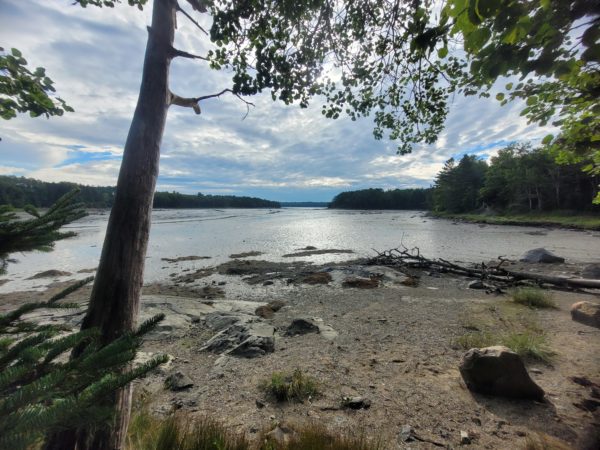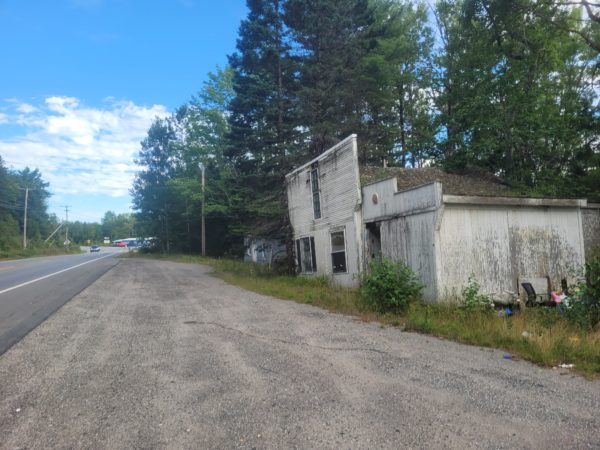The Sinclair Property: When The Shore Isn’t a Sure Thing
Over the course of this season I’ve discussed quite a few FBC preserves. There are over twenty of them, after all, all primed and perfect for an afternoon in nature. But these public-facing preserves are just part of the story. Roughly 13,000 acres of land across eastern Hancock County are under FBC ownership or easement, and only a portion are maintained with trails for public access. The remaining acreage has been conserved in order to protect critical habitat, wildlands conservation such as through forever-wild easements, or to protect harvester access to the shoreline – the topic of today’s blog. I’ll be discussing a tiny, unassuming piece of land in Sullivan that FBC helped to conserve earlier this year that protects the shoreline access that is so important to our local economy. This is the story of the Sinclair Property, and by extension, the on-going story of Maine’s shoreline.
A Tradition of Public Use
Maine’s enigmatic attributes have been a frequent focus of my writing, but there’s one topic I’ve yet to cover: public use of private land. For centuries the state has had a unique–and complicated–relationship with private property. Despite Maine’s high percentage of private land (94%, compared to a national average of 60.2%), it has been a bit of an unspoken rule that, unless stated otherwise, much of this land can be used for a variety of public activities. This right is cemented through a handful of laws–most notably in landowner immunity to recreator lawsuits and the extraordinary Great Ponds Law–but much of it relies on public compliance. It’s for this reason that proposals like a Northwoods National Park have faced some local ire; many private owners continue to allow activities like hunting and ATVing that would be restricted under this federal protection. This also applies to our tidelands, as state law designates the “intertidal zone” (defined as anything between the high and low tide mark) as public trust available for recreation and harvesting.
But these foundations have begun to totter.
A Costly Coast
Maine’s ownership is changing rapidly. Our land has become a fractured quilt, controlled by individual owners, legacy lumber barons, out-of-state forestry interests, resale speculators and investment groups. This has been a major crisis for those seeking to conserve the state’s interior–but that’s a discussion for another time. Today we’ll be focusing on the coastline.
Much of the state’s population is concentrated along the Gulf–year-round and seasonal both. And while there’s no feeding frenzy to grab up pieces of the interior woodlands for summer homes, the shoreline… well, that’s somewhat more in demand. The predominant purchasers of these waterfront parcels have been private individuals–Mainer and out-of-state both–for the purpose of vacation and/or rental. Shorefront properties have likewise seen a meteoric rise in value over the last two decades, beyond the means of the average year-rounder. And this has posed a serious threat to harvesters.
“But what about the law protecting access to our tidelands?”, you may ask. Maine has some pretty gnarly tides, after all, so that includes the majority of our coastline.
Well… there are two main problems.
All for Some, None for All
 Firstly, this legislation has been all but overruled by the state’s judicial branch. In a landmark case, Bell v. Town of Wells, the Maine Supreme Court overturned a ruling that private owners could not close off the tidal beach adjacent to their land. Through this ruling–which has never been revisited–they held that the town’s attempt at protecting public trust rights in the intertidal zone represented an illegal taking of private property. This has led to other cases–predominantly in the sandier southern counties–in which popular local beaches have been locked off by those able to afford coastal real estate. While it hasn’t prevented use of the tidelands elsewhere, it adds the threat of uncertainty.
Firstly, this legislation has been all but overruled by the state’s judicial branch. In a landmark case, Bell v. Town of Wells, the Maine Supreme Court overturned a ruling that private owners could not close off the tidal beach adjacent to their land. Through this ruling–which has never been revisited–they held that the town’s attempt at protecting public trust rights in the intertidal zone represented an illegal taking of private property. This has led to other cases–predominantly in the sandier southern counties–in which popular local beaches have been locked off by those able to afford coastal real estate. While it hasn’t prevented use of the tidelands elsewhere, it adds the threat of uncertainty.
Secondly, a right of use in tidal zones means nothing if the zone cannot be accessed. With the majority of coastal property in private hands, a hypothetical harvester may have to travel great distances from their nearest access point to their harvesting grounds. And often these areas cannot be reached at all. Most property owners simply bar access.
Clamming and worming have been keystone trades in coastal Maine for centuries; seaweed harvesting is a fast-growing local industry. Livelihoods of locals and their families rely on these public tidelands. So what can be done to avoid disaster?
Well, that’s where the Sinclair Property comes in.
(Sin)Clarifying the Sinclair Property
 You’ve very likely driven past the Sinclair Property; it is an inconspicuous landmark along Route 1. As one heads eastward towards Schoodic a shallow cove opens just before the road to Sorrento. This is Long Cove. A small parking area and restroom might draw the average eye, but the Sinclair Property is a little further east, at the head of the cove. Though currently featuring only a small gravel lot, two buildings in disrepair, and some overgrown brush — this property holds tremendous community value as a public access point for Long Cove.
You’ve very likely driven past the Sinclair Property; it is an inconspicuous landmark along Route 1. As one heads eastward towards Schoodic a shallow cove opens just before the road to Sorrento. This is Long Cove. A small parking area and restroom might draw the average eye, but the Sinclair Property is a little further east, at the head of the cove. Though currently featuring only a small gravel lot, two buildings in disrepair, and some overgrown brush — this property holds tremendous community value as a public access point for Long Cove.
Growing more and more in recent years has been the community-identified need to protect public shoreline access, and FBC is committed to playing a role in helping to meet that need. FBC worked with stewardship and acquisition partners Maine Coast Heritage Trust (MCHT) and Schoodic National Scenic Byway Committee to acquire the Sinclair property for the purpose of conserving shoreline access – a process that started in May 2022. MCHT initiated conversations with the landowner, before handing the project off to FBC.
FBC secured funding through the Maine Outdoor Heritage fund in early May to remove the two vacant buildings later this year, leaving space to create a gravel parking lot for clammers and wormers to park safely away from the busy street. Harvesters will be able to walk directly onto the mud flats, and not have to worry about losing their private access by permission.
Consideration for Conservation
As I’ve mentioned in an earlier post, “conservation” and “preservation” are two different things. While preservation seeks to “preserve”, typically through limiting human access and activity, conservation “conserves”–it manages natural resources so they may be utilized in safe and healthy ways. Clamming, worming and seaweed harvesting, when done properly and legally, do no major harm to our environment. They also provide food and incomes for many residents and have been practiced for generations–fitting comfortably under the “conservation” umbrella.
But there’s more to Sinclair than just that. After acquiring the property, FBC reached out to the town of Sullivan about transferring ownership over to the municipality. And Sullivan has accepted. FBC’s goal as the local land trust for eastern Hancock County is to benefit the community through conservation. Whether land is owned by the FBC or protected in easement or gifted to towns like Sullivan, it all ultimately works to that same altruistic end.
Unselfish Shellfishing
This may still seem like a somewhat insignificant transaction. A town acquiring a small parcel of land within its boundaries–so what? But Maine remains a state dominated by private ownership. The public use of this land is constantly teetering on a foundation of tradition and goodwill. And, like with Branch Lake Public Forest, municipal control will now protect this right for years to come. Sinclair will provide a crucial gateway for our local harvesters, ensuring they can access, and continue accessing, the tidelands they rely on.
But just one property can’t make all the difference. Maine’s coast cycles through areas of restricted and permitted shellfishing, allowing local species to rebound. With local harvesters largely filling the administrative roles that determine this, it’s a highly successful system. But, in order for the industry to survive, there needs to be stable access to a number of different bays and coves–meaning there’s still quite a bit of work to be done.
A Personal Note: Fears of a Child
When I was young, back when my time in Maine was the exception and not the rule, I loved trekking into the mudflats in front of our property. Gouldsboro Bay is rather shallow at its northwestern end, and, come low tide, we could venture out several hundred feet. But one day I noticed something odd: there was a person out there. I didn’t know that they were a harvester, or that “our” flats weren’t really ours, or that they had every right to be there–I was confused and a little angry. This was a concept wholly foreign to me at the time.
Now, as more summer homes have sprung up in Corea, I’ve seen less and less of the harvesters. And, as an outsider who started off as a summer resident, I can’t help but feel somewhat complicit.
But it doesn’t have to be that way.
An Outsider’s Plea
Here I will make an appeal to my fellow snowbird, summer resident and out-of-stater: keep an open mind and an open heart. Rather than thinking in terms of “local” versus “outsider”, think of yourself as an active part of one community. Even passive support towards our harvesters can make a difference (though, if you are interested in doing more, consider reaching out to your local township). And, above all else, don’t make the mistakes of my younger self. Countless people, organizations–even the state legislature–have fought to keep these tidelands open and accessible. Yet the blows of privatization and individualism and simple fear have been mighty.
So why not help take a stand?
